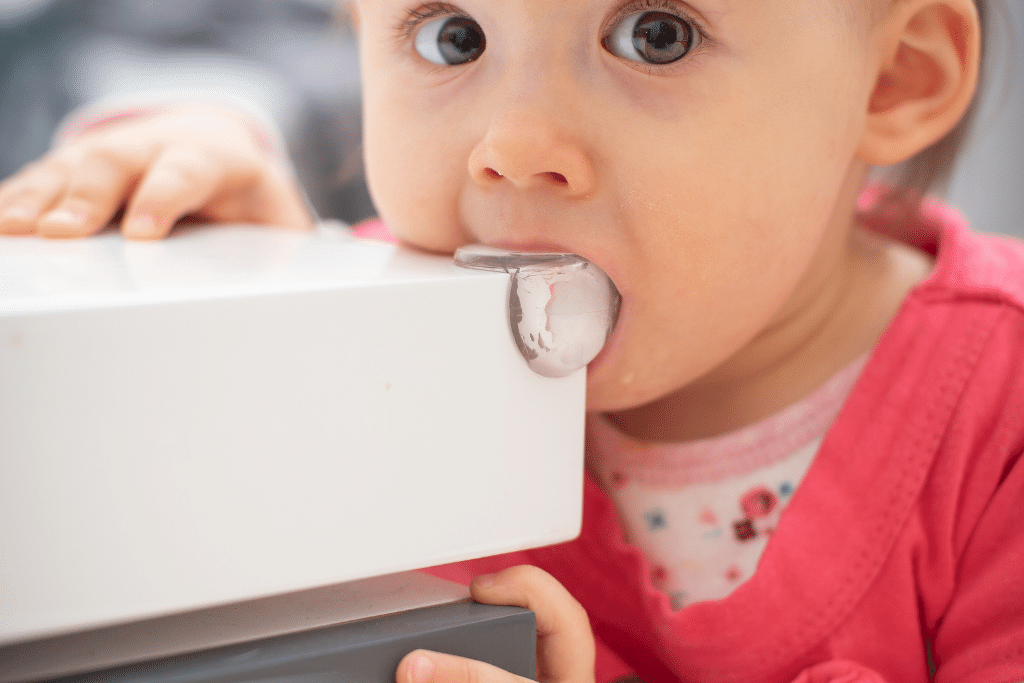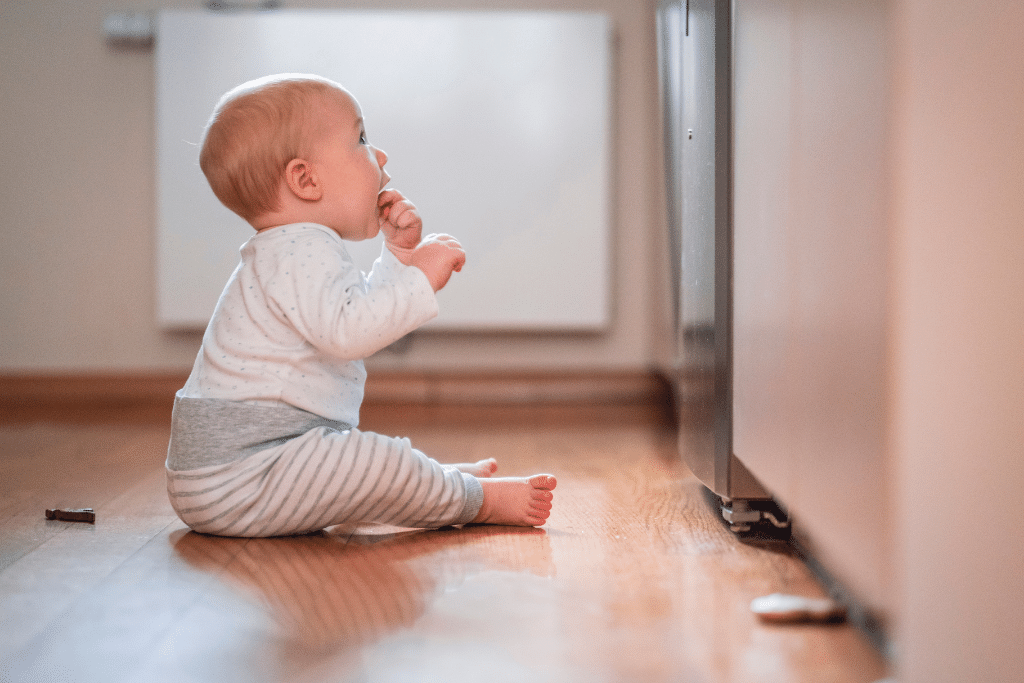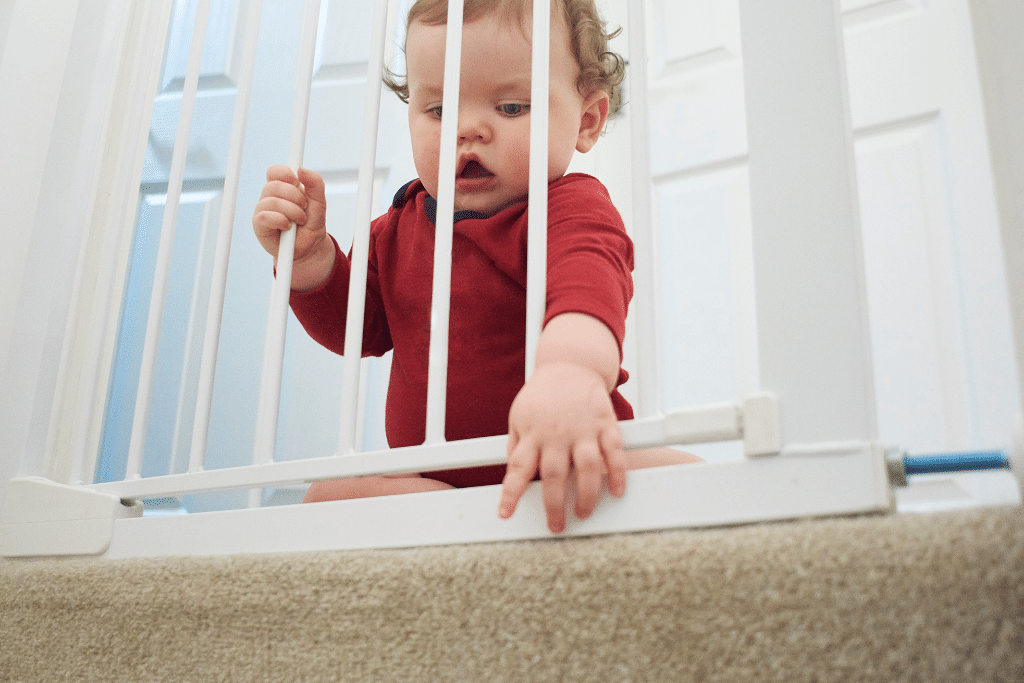Do you have your baby proofing checklist ready?
Your baby may seem so tiny now but before you know it, they are crawling and curious to know what’s in the cabinet, what will happen if they push the TV over, can they get off the bed on their own and so much more.
Babyproofing your house is necessary before they get to that stage.
Studies reveal that 1.3 million little kids are in the hospital emergency room due to injuries.
This is scary to think about. However, you do not have to worry because I’ll take you through several child-proofing ideas and guide you to create an effective babyproofing checklist.
Baby Proofing Checklist – What You Need To Do

We’ll go through this checklist room by room to ensure your child is safe, no matter what part of the house they are in.
Baby proofing the living room
When baby-proofing the house, the idea is to try to foresee anything that can harm your baby and get rid of them or do something to minimize the risk of that item hurting your child. For example, the potentially dangerous areas in the living room include fireplaces, furniture, electronics, and electrical cords.
Below are ways you can babyproof your living room.
Cover the sharp edges of your furniture
It is easy for a child to collide with the sharp edges of a table while moving around, which can be extremely painful.
You can prevent this by covering these sharp corners with corner protectors.
Another alternative is buying safer furniture. For example, instead of the regular rectangle coffee table, you can go for the circular one. Since it doesn’t have sides, there are no sharp edges. This is the first change I made when my baby showed signs of crawling.
If you already invested in a table and are not looking to buy a new one, you can get babyproof coffee table covers. The idea is to cover the sharp edges that can hurt your child.
Attach furniture and some appliances to the wall
Babies climb on almost everything, or at least try to and so will your little one. When some items are not attached to the wall, they can fall and land on your baby, which you don’t want to think about.
Research shows that a child is taken to the emergency room every 30 minutes due to a TV falling on them. Kids below 5 years sustain most of these injuries because it’s harder for them to move out of the way in time.
Before we got pregnant, our TV was sitting beautifully on its stand and we were okay with it. However, after conceiving, for some reason I would come across clips on social media of kids attempting to climb the TV and the screen falling on them. I had nightmares from imagining that happening to my child. So before I was discharged from the hospital, I requested my husband to mount our TV on the wall. That gave me peace of mind and we’ve never had those kinds of accidents.
So mount your TV, cabinets, wall clocks, and so on.
Ensure cords are not lying around
A dangling cord can strangle a kid when they wrap it around their neck. That’s why it’s important to ensure you don’t have those lying around.
If your window blinds have cords, make sure they are not hanging low enough that your child can reach them. You can shorten or secure them higher on the wall if they are. Another option is to go for cordless blinds or shades. This is how to babyproof curtains.
When it comes to electrical cords (for computers, TV, woofer, etc), it is advisable to tuck them behind these appliances so they are out of the baby’s reach.
You can then cover the electrical outlets even if you feel like your baby’s fingers are way too small to fit into them. You can also block these outlets using furniture. If you don’t have this task on your babyproofing checklist, it’s time to include it.
Ensure fireplace safety
Depending on how old your baby is, you can teach them that a fireplace is dangerous and they shouldn’t play with it. But before we get there, you can block off the area using big gates that extend up to the wall to be sure your baby can’t get through.
Don’t use fireplace screens because your baby can trip over them. Glass screens can also get extremely hot and burn your child if they touch them.
You can also keep the fire matches high to prevent your baby from accessing them.
It is also important to ensure your baby isn’t near the fireplace without adult supervision.
Baby proofing the nursery
The nursery is one area that cannot miss on our baby proofing checklist because children spend a lot of time in it. The main thing you can focus on here is preventing your baby from falling or suffocating. Here are some childproofing ideas for the nursery.
Have a bare crib
You might be tempted to put some things like stuffed animals, toys, pillows, books, extra blankets, etc in your baby’s crib because you think the baby needs them or they look beautiful in it. However, these items increase the chances of your baby suffocating when they cover themself with them and are unable to remove them.
A bare crib is a safe one and that’s what a baby needs. Additionally, it also provides a conducive sleeping environment which is one of the tips on how to get babies to sleep longer stretches at night.
Have a window guard
If you normally open the nursery windows to allow in fresh air or if your baby can open the window on their own, you need a window guard.
Kids don’t understand the dangers of climbing out of the window and so their curiosity can push them to do that. They cannot achieve this with window guards and so they protect your baby from getting injured or worse.
Have barriers at the door
Toddlers like running around and moving from room to room and they can even do this when they wake up while you are doing chores or at night while you’re sleeping.
They can trip over items, go to the kitchen and touch dangerous things like knives or turn on the cooker so that’s why it’s important to put a barrier at their door to avoid this.
To give you peace of mind, you can install video monitors to see when they are awake so you can get them or remove the barriers.
Have an open toy box
Children love playing with toys and they’ll go to great lengths to access them. That is why it’s not advisable to keep toys locked away because your baby can hurt their fingers as they struggle to open the heavy lid or climb inside the box and get stuck.
Getting a large open basket or toy box is what should be on your babyproofing checklist.
Make the crib safe
According to research, beds are responsible for most of the injuries that children aged 12 and below experience. This is because they can easily roll or slide off them and fall in the process. Therefore, it’s important to ensure the crib is safe enough for the baby.
You can do this by:
- Keeping the crib away from the window. If your window curtains or blinds have cords, the baby can reach them from his or her crib and wrap them around their neck while playing.
- Lower the crib base/mattress. This will prevent the baby from falling down as they climb out of the crib since it will be close to the ground. You can also add a thick carpet on the floor to ensure that even if they fall, they won’t feel the impact.
- Don’t hang things over the crib: Although hanging items like nursery mobiles can entertain the baby and soothe them to sleep, they can also be dangerous if they fall and land on the child. If you decide to still use them, make sure they are securely fastened. Also, avoid hanging heavy stuff like paintings, mirrors, picture frames, or art directly over the crib for the same reason. If screws come off or the nails weaken, it can be fatal.
Secure the furniture
In the spirit of exploring, your baby can grab the dresser or changing table and attempt to pull them. Depending on their strength and age, the furniture can tip over and fall on them which is something we don’t want.
So what should be on your babyproofing checklist? Securely mount your baby’s changing table or dresser to the wall.
If you’re interested in small nursery room ideas, check out this article.
Cover your nursery garbage
Kids will crawl and touch anything within their reach, including the waste bin in the nursery. You can’t imagine your baby eating the poop from their used diaper. That’s why you should keep it covered.
Another tip you can use is to correctly wrap the diaper before disposing it or even double wrapping it and also frequently emptying the trash bin.
Baby proofing the kitchen

Hot water, a cooker, an electric kettle, a mixer grinder, and various appliances are found in the kitchen, which makes it a dangerous place for children. Therefore, we must include the kitchen when discussing baby-proofing an apartment.
Let’s look at how you can make the kitchen safer for your precious one.
Avoid small magnets on the fridge
I know fridge magnets come in handy when you want to remember important appointments or even for putting your shopping list. However, it is advisable to avoid using the tiny ones, especially if you have small kids and you’re trying to baby-proof your house.
Keep sharp objects away
It goes without saying that sharp objects can cause serious injuries and that’s why they should be kept out of reach of children. Examples of these objects include knives, scissors, glasses and dishes (they are sharp when they break), and forks.
These shouldn’t be left on the kitchen counter but instead kept in high drawers or drawers with latches.
Even the foil cutting strips are usually sharp and should be kept out of children’s sight or reach.
Keep cleaning supplies out of reach
One time I came home from work and my daughter greeted me at the door with her face covered in washing powder. My housekeeper was cooking in the same kitchen and it only took my daughter seconds to get the powder from under the sink and pour it on her face. That’s the time I walked in and I knew we had to do something so I called a maintenance man who installed doors on the cabinets under the sink together with locks.
If you can avoid storing your cleaning products under the sink, please do. You don’t want your child chewing on the dishwashing sponge or drinking bleach. If you can keep them somewhere high, the better but if not then at least fix some cabinets below it and put locks.
Invest in stove-knob covers and oven locks
Kids can turn on stove burners when they get a chance because they are curious and want to know what will happen. This can be dangerous especially if you don’t realize it in time.
According to the World Health Organization (WHO), burns are number 5 on the list of serious childhood injuries that may not necessarily lead to death.
A report published by the American Burn Association revealed that more than 300 children are rushed to the hospital emergency rooms daily due to burns and an average of 2 kids usually succumb to their injuries.
From these statistics, you can see that preventing burns should be a top priority when thinking about baby-proofing your house or apartment.
You can achieve that by investing in stove-knob covers because they make it impossible for your child to turn the stove on. If you hadn’t considered this before, you should add it to your baby proofing checklist.
You can also get an oven lock since the oven door is usually only a few meters from the ground and so a child can easily pull it open and put their hand inside it. If there’s something cooking inside, meaning the oven is hot, it can result in burns, The lock prevents this from happening.
As a general rule, don’t leave the cooker stove unattended if you have young children because they only need seconds to touch something hot and get burned.
Making sure kids spend as little time as possible in the kitchen also increases their safety. Of course, when they are a little bit older (past the toddler stage), it becomes easier to have them in it as you cook or spend time together because they’ll understand the dangers of doing certain things like touching a hot stove. They can’t understand this when they’re young.
Keep matches away: Place them somewhere your baby can’t reach or lock them away and they won’t be able to light things up.
Baby proofing around the home

Although we’ve tackled the main areas of the house where you can babyproof, there are also other things you can generally do to ensure your baby’s safety.
Lock up alcohol and medicine
Your baby can consume alcohol if they’re left lying around and this has so many dangers. They can also break the bottle (for example if it falls over) and the glass can cut them.
Taking adult medicine can also have serious negative effects on your baby, which is something you wouldn’t want.
Baby proof the stairs
Creating barriers on your stairs should be on your babyproofing checklist if your house has a staircase. You can do it at the top and bottom to ensure they don’t go up or down and accidentally fall or roll backward.
Alternatively, you can install gates that adults can operate but toddlers can’t.
Always close the toilet lid
Take it a step further and put a safety latch on it so your baby can’t lift up the lid and accidentally fall inside or touch the water and then touch their mouth.
If you have a home office, you can ensure electric cords are out of the way and also put away small items like pins, paper clips, and staples that your baby can put in their mouth and possibly choke on.
Avoid having buckets of water around
Children like playing with water and they can end up drowning if they fail to get themselves out in time and there’s no adult in sight. If you must have the water around then ensure there’s a barrier to that room or area so your baby can’t get to it.
Final Thoughts
When creating a baby-proofing checklist, think of what could possibly harm your child and then change that situation. I hope these childproofing ideas have given you an insight into what you can work on in your home to make it safer for your child.
When in doubt, just crawl on the floor like your child would or does and move around. You’ll be surprised at the number of items you’ll find out of place like cords and sharp objects lying around. Once you know what you need to work on, get your baby-proofing necessities ready and start the process. I wish you the best on your babyproofing journey.
Good luck mom hero!
Hi – I’m Alina and I am a soon to be mom going through the journey of becoming a parent. I am a writer at heart and I love sharing about pregnancy tips and other busy mom hacks.
